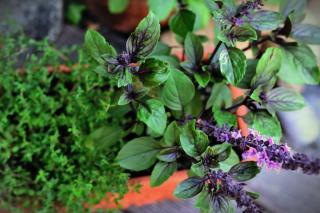

What is more pleasant on a sunny than spending a few moments to relax in the garden. Pretty often, though, we restrict the experience to simply contemplating the beauty of trees, shrubs and flowers. That’s of course very true. However, let us not forget that gardens can also stimulate your other senses, too: smell, touch, taste and hearing. How can this be? The solution is quite straightforward: create a sensory garden.
The first of all senses when we imagine a garden in our mind’s eye, is, of course, sight. Before even hearing, smelling, touching or tasting, as one enters the garden, colors and shapes are what stand out, those of flower beds for example. It’s also perhaps the easiest sense to please, and for that, simply follow our guide on planting a flower bed.
 Second sense that rises to awareness in the garden: smell. What a pleasing sensation to inhale the sweet fragrance of flowers, the scents wafting from leaves when the hand or a breeze rustles through them.
Second sense that rises to awareness in the garden: smell. What a pleasing sensation to inhale the sweet fragrance of flowers, the scents wafting from leaves when the hand or a breeze rustles through them.
 If you’re into hugs over handshakes, you’re definitely a tactile person: it’s very easy to stimulate your sense of touch in the garden. There may be various paths to this:
If you’re into hugs over handshakes, you’re definitely a tactile person: it’s very easy to stimulate your sense of touch in the garden. There may be various paths to this:
 Apples, pears, strawberries, raspberries, cherry tomato quickly come to mind when the idea of fruits and berries arises. However, there is a number of much more original plants that will also set your taste buds tingling. For instance, in no particular order: sage, chocolate mint or peppermint, oregano, chives, lemon thyme, etc.
Apples, pears, strawberries, raspberries, cherry tomato quickly come to mind when the idea of fruits and berries arises. However, there is a number of much more original plants that will also set your taste buds tingling. For instance, in no particular order: sage, chocolate mint or peppermint, oregano, chives, lemon thyme, etc.
Go for an even more surprising pick with a plant that tastes like oysters, Mertensia maritima!
In truth, this isn’t the easiest of senses to stimulate in the garden, but, nonetheless, with just a few easy tricks, your garden will become a wonder for the ears even as your eyes stay closed.
Some species such as birch and poplar have leaves that are so light that the slightest breeze sends them trembling. Grasses can also send soft music to your ears. Taller species are better for this, such as Miscanthus or pampas grass.
 A garden is more than just plants. Nothing should stop you from adding water into your own patch of greenery. Set a fountain or a waterfall up in a small basin for instance. No need for heavy machinery, there are many easy and affordable options, such as solar-powered fountains that float on water directly.
A garden is more than just plants. Nothing should stop you from adding water into your own patch of greenery. Set a fountain or a waterfall up in a small basin for instance. No need for heavy machinery, there are many easy and affordable options, such as solar-powered fountains that float on water directly.
With a few melliferous plants, you’ll call onto all pollinator insects to come set up shop in your flower beds. This will let you wallow in the soothing buzz of honeybees for instance. These particularly love lavender, lime trees, Eucryphia, Saint John’s wort, etc.
In addition to the natural sounds of rustling foliage, hand a few wind chimes in the wind, they’ll add a soft jingle to your sensory experience. With all these ideas, get ready to multiply the pleasant experiences that await in your garden, switching from one pleasant sensation to the next.